This is Part 2 of the How to Play Singapore Mahjong series . Check out Part 1 here if you have missed it.
In Part 2, I will share more on the basic rules of Mahjong. This part is split into the following sections:
2.1 Seat Selection
2.2 Setting Up
2.3 Initial Draw
2.4 Replacement Draw (补花 Bǔ Huā)
2.5 Player Moves
2.5.1 Draw (摸牌 Mō Pái)
2.5.2 Chow (吃 Chī)
2.5.3 Pong (碰 Pèng)
2.5.4 Kong (槓 Gàng)
2.5.5 Mahjong (胡 Hú)
2.5.6 Priority Order of Moves
2.6 Stalemate

2.1 Seat Selection
To begin the playing a Game, the players’ seats are first selected through a dice roll. There are many variants of seat selection methods, but I will share one of the most common methods using three dice below:
1. Shuffle one of each of the four Wind Honor tiles (风牌 Fēng Pái) face-down on the Mahjong table.
2. All four players take turns to roll three dice and rank themselves in the order of the sum of their dice roll.
3. The player with the highest dice roll gets to select from the face-down tiles first, followed by the player with the second-highest roll until the fourth player has selected the last tile.
4. All four players reveal their selected tiles to find their Seat Winds.
The player who selected East (東 Dōng) is the First Dealer and gets to choose the exact seat, with the other players following based on their Seat Wind accordingly. The First Dealer will have the Prevailing Wind marker placed at the left corner as an indication.

2.2 Setting up
After the players have taken up their positions based on the Seat Winds selected, they begin setting up the Hand by shuffling the tiles face-down on the Mahjong table.
Trivia: The act of shuffling the tiles mirrors that of breaststoke and Singaporeans often tease Mahjong being dry swimming 🤣.
After shuffling, players proceed to stack a two-layer Mahjong Wall in front of them. The number of tiles in the wall depends on the Seat Wind. The players at East (東 Dōng) and West (西 Xī) stacks a 19-tile wall, while the players at South (南 Nán) and North (北 Běi) stacks a 18-tile wall. Players then push each wall towards the centre of the table with a diagonal offset, forming a square wall.


2.3 Initial Draw
To start playing the Hand, a dice roll will be used to determine the exact point to cut the tile wall and draw the initial set of tiles:
1. The Dealer (East, 東 Dōng) rolls the three dice and sums up the total.
2. Starting from the Dealer (East, 東 Dōng) with 1, count anticlockwise (i.e. South 南 Nán is 2 and so on) until reaching the dice total. The chosen player’s tile wall will then be used for cutting.
3. Start counting from right to left of the chosen tile wall using the same total from the dice throw to determine where the exact point to cut in the tile wall.
4. The tiles to the left of that point represents the Open Wall. The tiles to the right represents the Dead Wall.
4. The Dealer (East, 東 Dōng) starts by drawing 4 tiles from the Open Wall, followed by the player on his right (South 南 Nán) in an anticlockwise direction until all players have 12 tiles each.
5. Each player then draws their 13th tile as shown in the diagram, with the exception of the Dealer who draws a 14th tile.
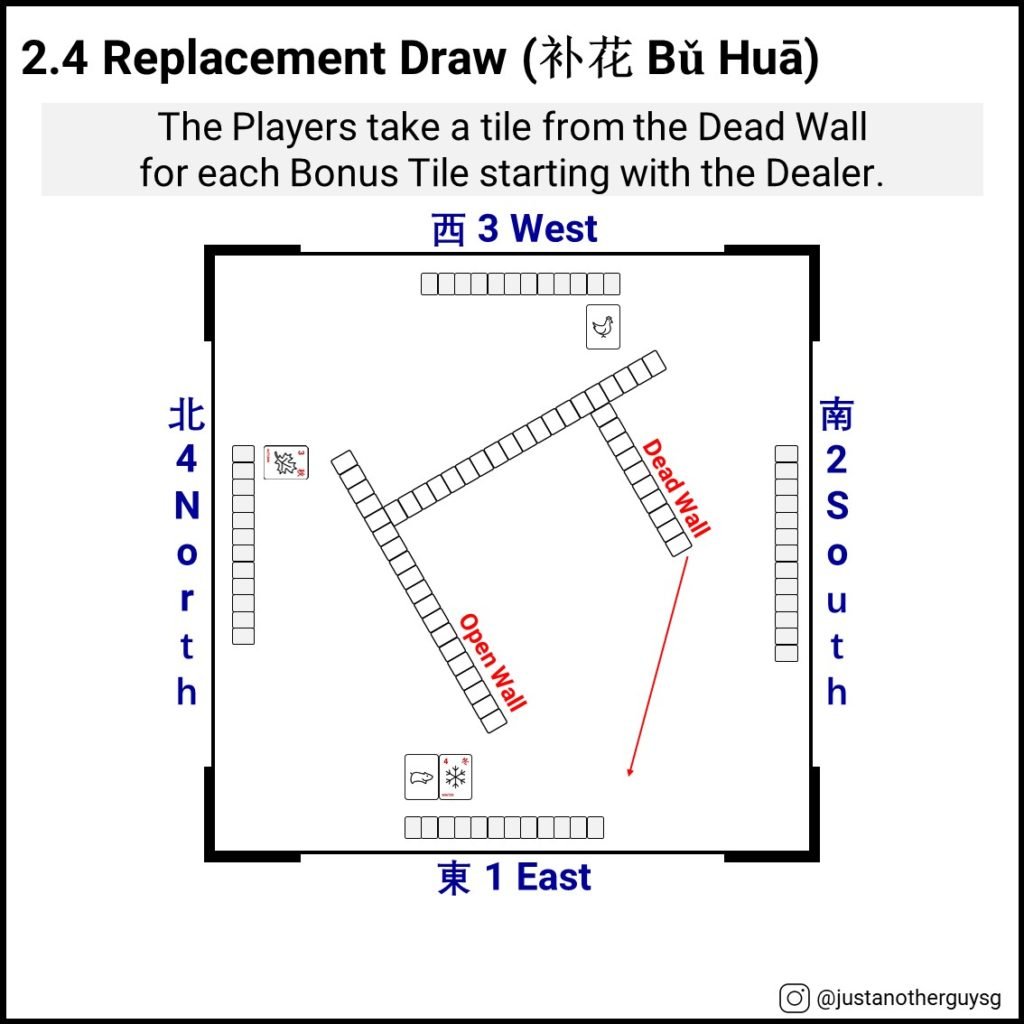
2.4 Replacement Draw (补花 Bǔ Huā)
With the opening hand drawn, the players then open the tiles with the back of the tiles facing the other 3 players. Other than arranging the tiles in chronological order to facilitate reading the tiles, players will reveal any Bonus tiles (i.e. Flowers and Animals) face-up in front of them to other players and perform a Replacement Draw (补花 Bǔ Huā) in an anticlockwise direction starting with the Dealer.
A Replacement Draw is performed by taking a tile for each Bonus tile from the Dead Wall. If a player draws any Bonus tiles from the Replacement Draw, another Replacement Draw is performed again, but only after the first cycle of Replacement Draw has been completed.
Bonus tiles do not count towards the 14-tile combination required to win the game. With the Replacement Draw(s) completed, the Hand is ready to begin with the Dealer having 14 tiles and the other players having 13 tiles each.

2.5 Player Moves
Before going into details of the different moves available, let us explore WHY we perform them in the first place.
Recall from Part 1 that the objective of the game is to be the first in forming a winning combination of 14 tiles. However, each player will start and always have 13 tiles (either exposed and concealed, explained later) with them at any point in time. Thus, the only way to win is to obtain an additional tile through drawing from the wall or taking a discarded tile from other players.
Every move is made to improve the overall chances of getting to the 14-tile winning combination. This is akin to taking one step at a time on a long flight of stairs. Although small, it helps to advance to the top, but at the at the same time, a misstep can send one tumbling to the bottom.
Players will conceal their tiles, unless the moves made require revealing or exposing them (such as the Bonus tiles mentioned in the Replacement Draw above). Exposing your tiles provides an informational advantage to the other players as they will be able to (1) measure your progress towards winning and (2) guess your winning combination. Thus, making a move is about the delicate balance between advancing towards winning and not revealing too much about your tiles. 😉

2.5.1 Draw (摸牌 Mō Pái)
During the Player’s turn, the Player draws a tile from the Open Wall and adds it to their hand. The Dealer’s initial hand of 14 tiles has already included the first draw made as part of the rules.
If a Flower or Animal Bonus Tile is drawn, the player performs a Replacement Draw (similar to 2.4 above).
If the Player does not win with the tile drawn, the Player then selects and discards one tile into the Discard Pool in the centr. Hence, if the Dealer does not win with the initial 14 tiles drawn, the Dealer then discards one tile into the Discard Pool to start the game.
The Player’s turn ends with the discard and the turn passes onto the player on the right in an anticlockwise direction.
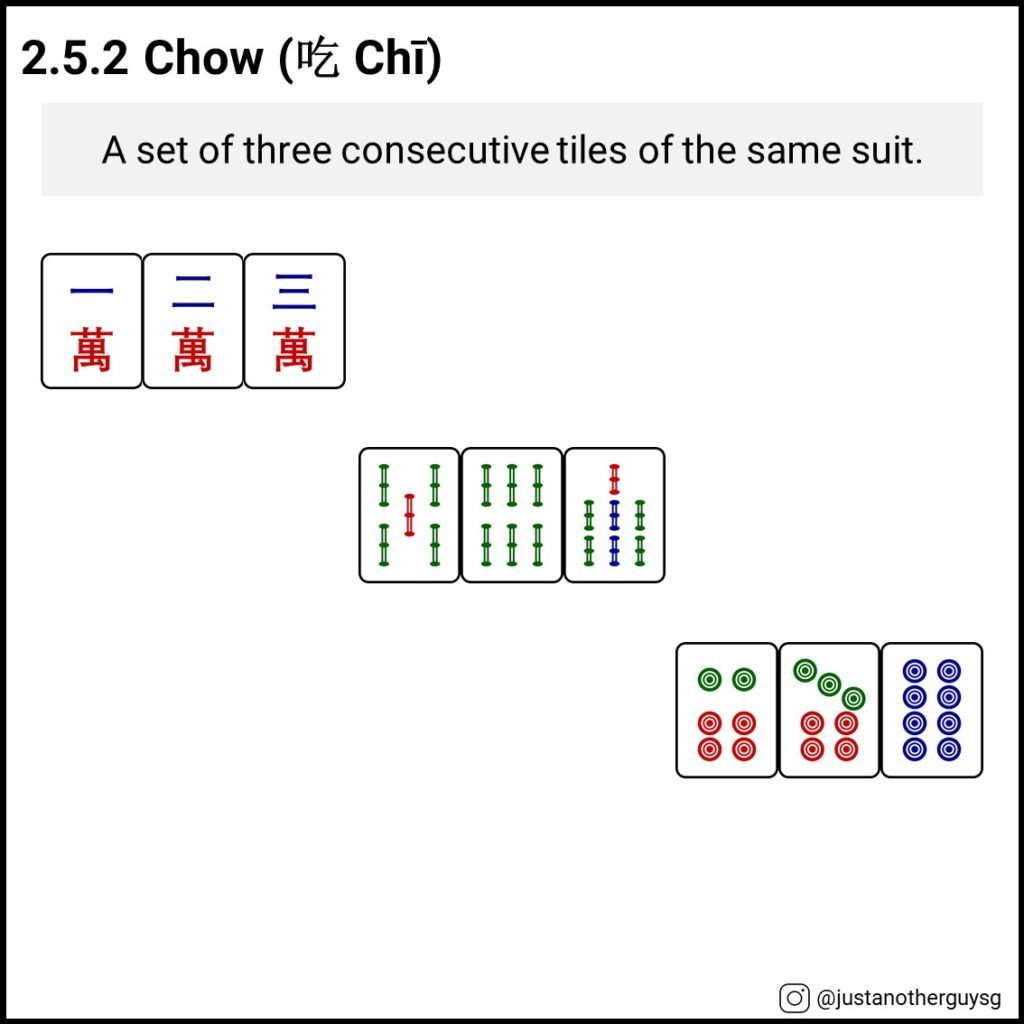
2.5.2 Chow (吃 Chī)
Chow is a set of three consecutive tiles of the same suit. This can only be made using Suit tiles as Honors do not have a numerical value and Bonus tiles are excluded from winning combinations.

Concealed Chow
This is formed by drawing tiles to form a Chow in your hand. A Chow formed this way can be kept in your hand need not be revealed until you win.

Exposed Chow
This is formed by taking the tile discarded by the player immediately to your left (e.g. West Player can only take the tile discarded by the South player) and combining it with two consecutive tiles in your hand to form the Chow. The Player will announce Chow! and reveal the Exposed Chow to the other players, before selecting and discarding one of the remaining tiles in the hand.
The Player’s turn ends with the discard and the turn passes onto the player on the right in an anticlockwise direction. Note that the Player gives up the opportunity to draw a tile from the Open Wall in order to perform an Exposed Chow when the opportunity arises. Thus, there is a need to evaluate which of these is a better move during each situation.
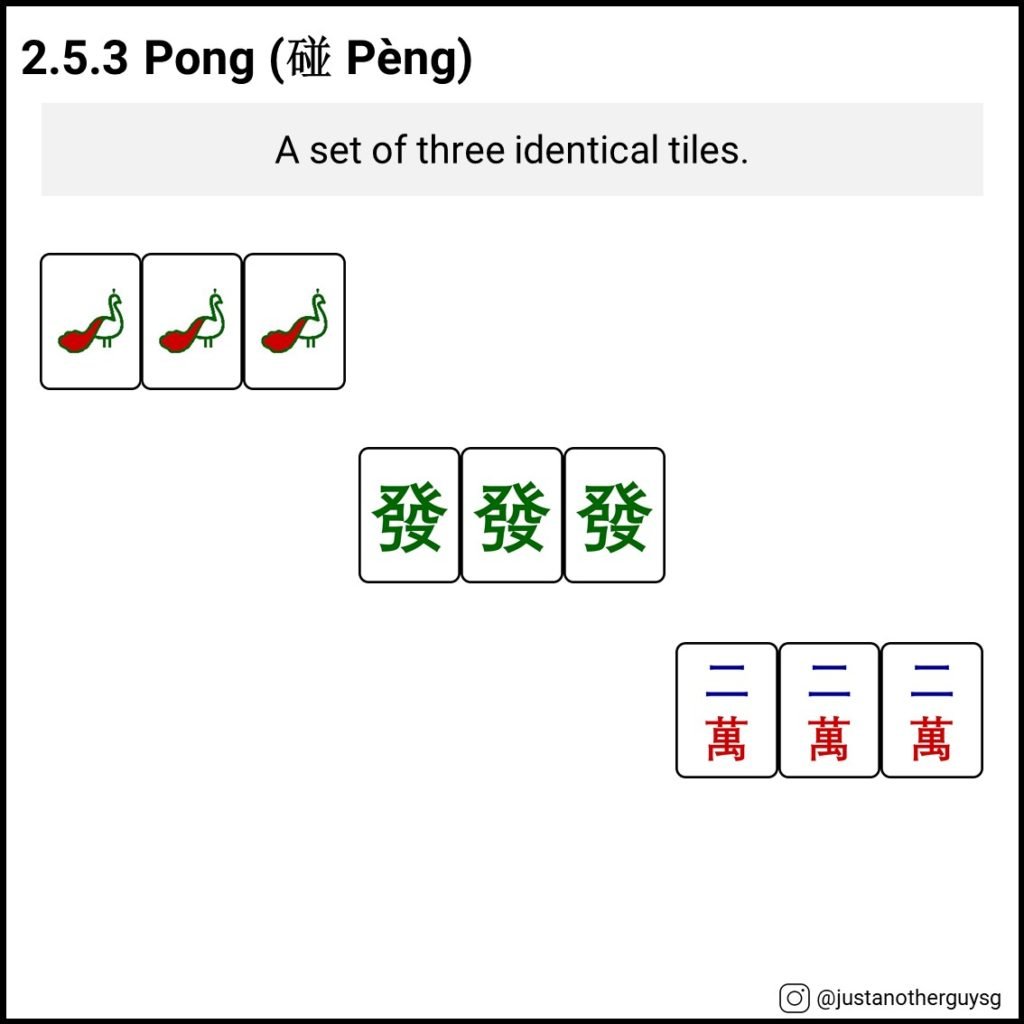
2.5.3 Pong (碰 Pèng)
Pong is a set of three identical tiles. This can only be made using Suits and Honors tiles, but not Bonus tiles as they are excluded from winning combinations.
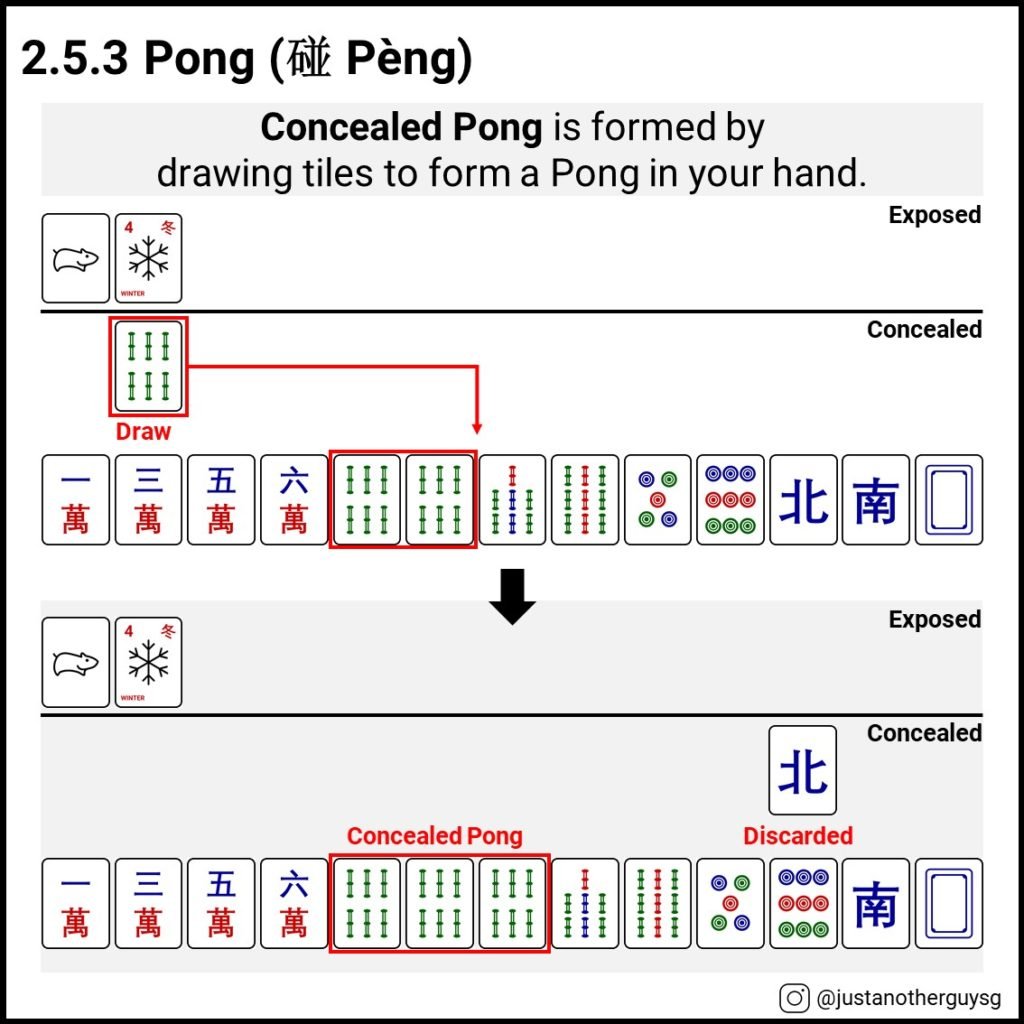
Concealed Pong
Similar to the Concealed Chow, this is formed by drawing tiles to form a Pong in your hand. A Pong formed this way can be kept in your hand need not be revealed until a Kong is made (explained below) or you win.
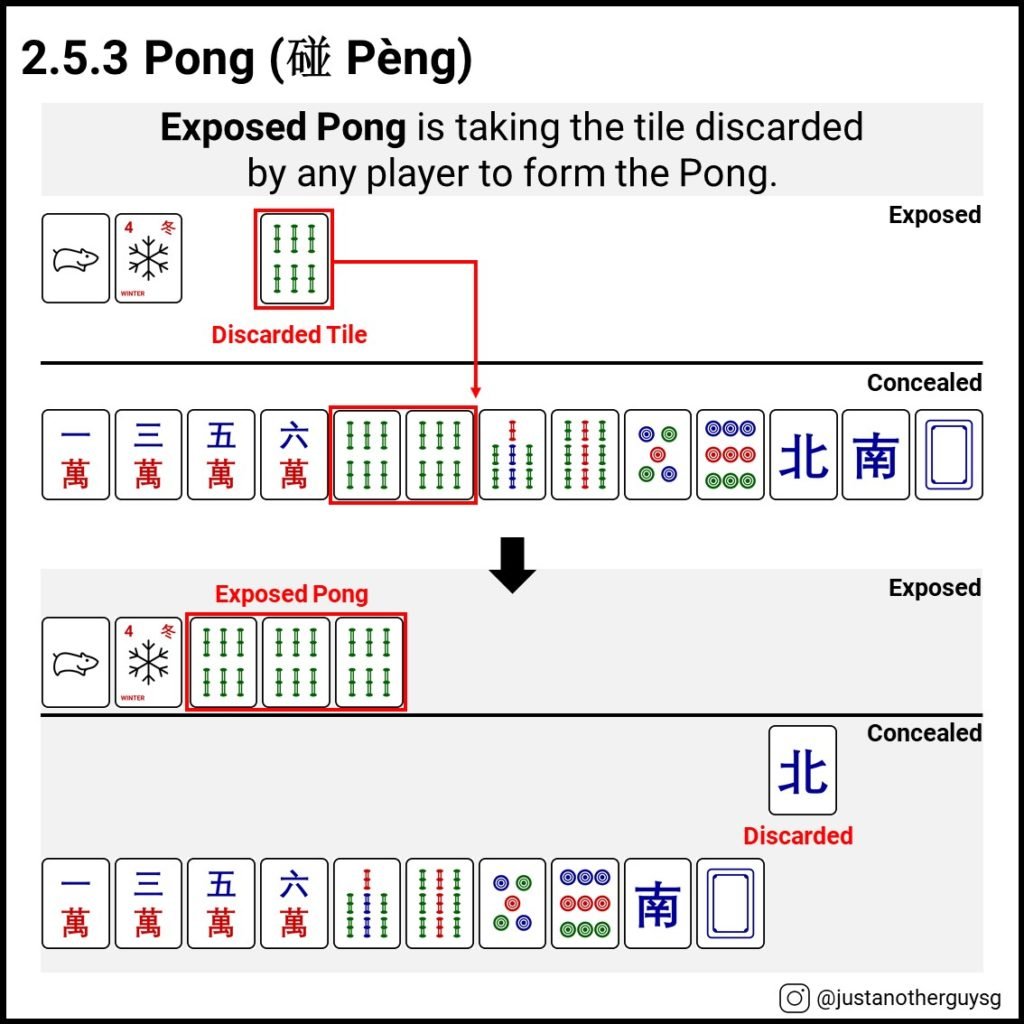
Exposed Pong
This is formed by taking the tile discarded by any player (contrast this with Exposed Chow) and combining with two identical tiles in your hand to form the Pong. The Player will announce Pong! and reveal the Exposed Pong to the other players, before selecting and discarding one of the remaining tiles in the hand.
The Player’s turn ends with the discard and the turn passes onto the player on the right in an anticlockwise direction. Note that a Pong interrupts the anticlockwise flow of the game as the turn immediately skips to the Player who performs an Exposed Pong. Similar to the Exposed Chow, the Player does not draw a tile from the Open Wall, but instead discard a tile after performing an Exposed Pong.

2.5.4 Kong (槓 Gàng)
Kong is a set of four identical tiles. This is an upgraded version of Pong. Similar to Pong, this can only be made using Suits and Honors tiles, but not Bonus tiles as they are excluded from winning combinations.

Concealed Kong (暗槓 Àn Gàng)
This is formed by drawing tiles to form a Kong in your hand. The Player may then choose to (1) reveal the set of Concealed Kong to obtain an Instant Payment (elaborated in the next Part) or (2) use the four tiles separately in other combinations (e.g. one set of Concealed Pong and the fourth tile for a Chow).
If the Concealed Kong is revealed, the Player gets to performs a Replacement Draw from the Dead Wall, before selecting and discarding one tile. The Player’s turn ends with the discard and the turn passes onto the player on the right in an anticlockwise direction.
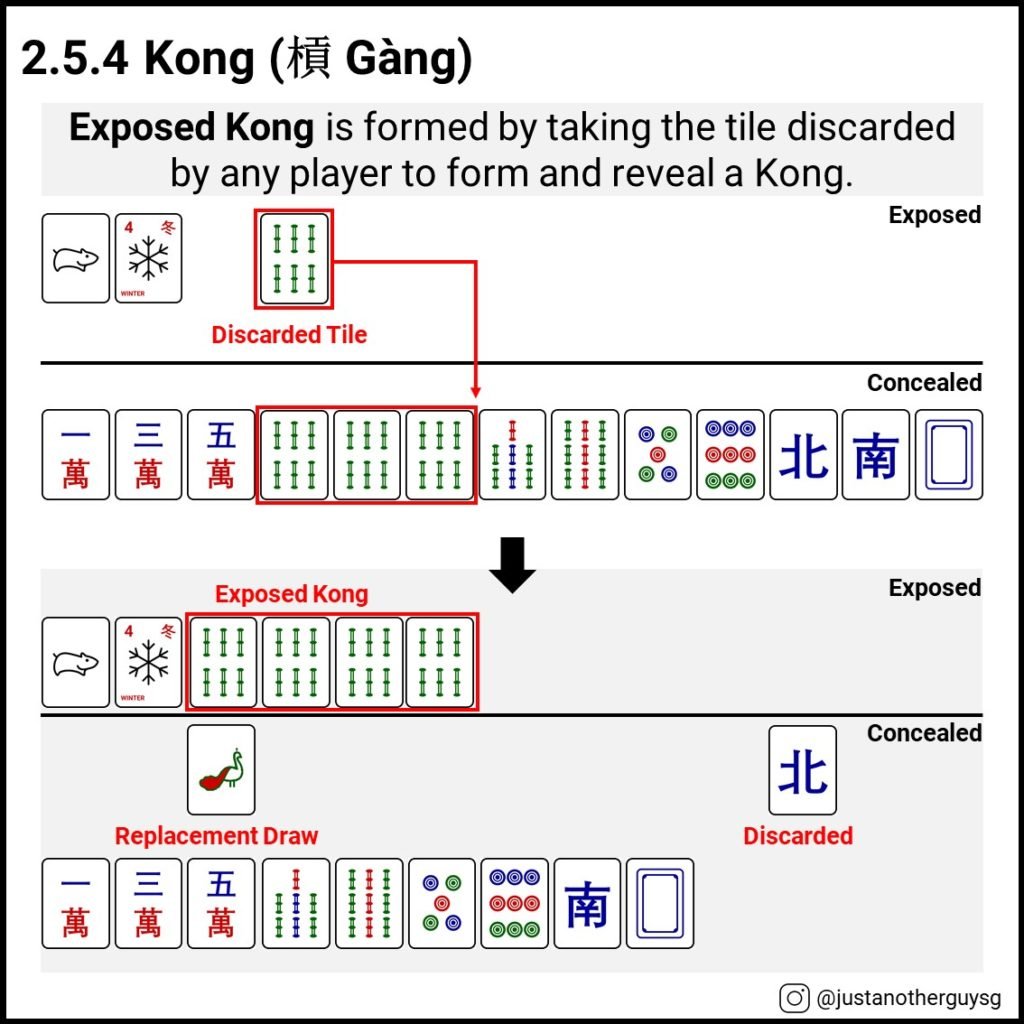
Exposed Kong (明槓 Míng Gàng)
This is formed by taking the tile discarded by any player and combining it with three of the identical tiles in your hand to form the Kong. The Player will announce Kong! and reveal the Exposed Kong to the other players to receive an Instant Payment. The Player then performs a Replacement Draw, before selecting and discarding one of the remaining tiles in the hand.
The Player’s turn ends with the discard and the turn passes onto the player on the right in an anticlockwise direction. Note that a Kong interrupts the anticlockwise flow of the game as the turn immediately skips to the Player who performs an Exposed Kong.

Exposed Kong from Exposed Pong (明槓 Míng Gàng)
This is formed by drawing and exposing the fourth identical tile when the Player already has an exposed Pong. The Player will announce Kong! and place the fourth tile with the Exposed Pong to form the Exposed Kong to receive an Instant Payment. The Player then performs a Replacement Draw, before selecting and discarding one of the remaining tiles in the hand.
The Player’s turn ends with the discard and the turn passes onto the player on the right in an anticlockwise direction.

2.5.5 Mahjong (胡 Hú)
A Player wins the Hand with Mahjong by either (1) drawing the winning tile or (2) taking a discarded tile as the final tile required to complete the 14-tile winning combination.
When this happens, the Player reveals the remaining concealed tiles for inspection and the Hand finishes. The score of the winning combination is calculated and the players get ready for the next Hand.

2.5.6 Priority Order of Moves
After going through the Player Moves, you may notice that a single discarded tile may possibly be used by the other three players to perform a Chow, Pong / Kong or Mahjong. The game addresses this situation by setting a Priority Order of moves in decreasing priority as follows:
1. Mahjong (Highest Priority)
2. Pong / Kong
3. Chow (Lowest Priority)
Hence, when there is a contest between Pong / Kong and Chow for a discarded tile, the Pong / Kong overrules and the turn skips to the Player performing the Pong / Kong. The Player who wanted to perform the Chow can either wait for the final tile (if any) or explore other combinations instead.
Sometimes, some players’ turns may be skipped due to an interruption of the anticlockwise flow from a Pong / Kong. This is part and parcel of the game, and the game does not have a mechanism to compensate for the missed turns.

2.6 Stalemate
The Hand finishes with either a player forming Mahjong, or if the players draw until there are 15 tiles left in the Dead Wall. In the latter case, it is considered a Stalemate and the players play an additional Hand with the current Hand’s Prevailing Wind and Seat Winds (as mentioned in 1.5 of Part 1).
However, if any player has managed to form a Kong by the time there are 15 tiles left in the Dead Wall, the Hand is deemed to have finished and the players move on to play the next Hand.
With this, I have covered the basic rules of Mahjong. Feel free to comment down below if you have any questions.
Next, I will touch on Winning and Scoring in Part 3. Stay tuned! 😄
Icons sourced from icons8.

Dude, this has got to be the clearest and most concise guide out there on the internet. Love the diagrams and the way the game is explained!
Thank you for your kind comments! Check out the just released final Part 3 of series for Winning and Scoring if you are keen! 😄